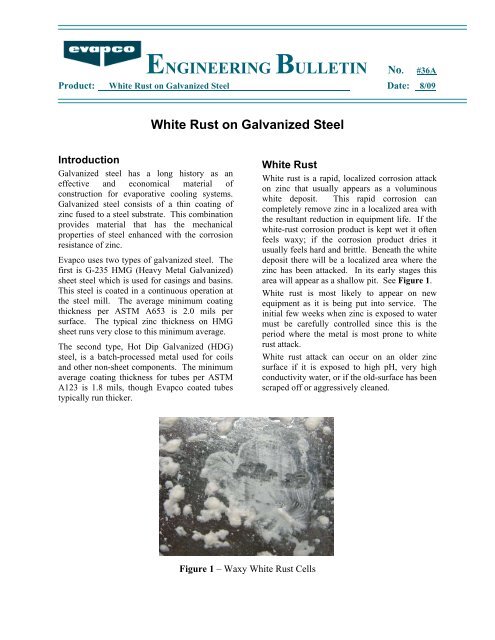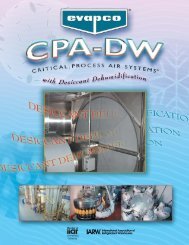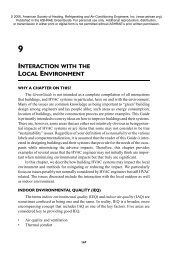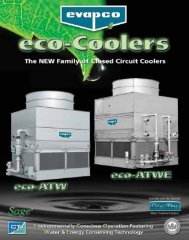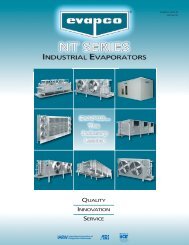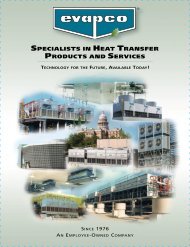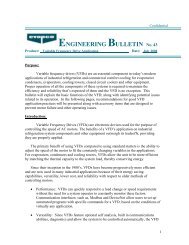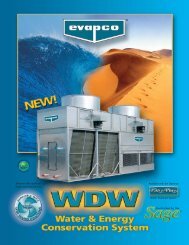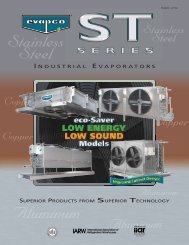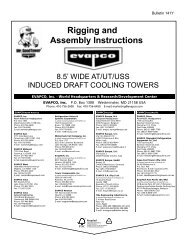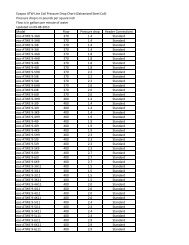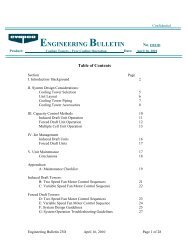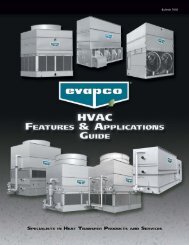White Rust on Galvanized Steel
White Rust on Galvanized Steel
White Rust on Galvanized Steel
Create successful ePaper yourself
Turn your PDF publications into a flip-book with our unique Google optimized e-Paper software.
ENGINEERING BULLETIN No. #36A<br />
Product: <str<strong>on</strong>g>White</str<strong>on</strong>g> <str<strong>on</strong>g>Rust</str<strong>on</strong>g> <strong>on</strong> <strong>Galvanized</strong> <strong>Steel</strong> Date: 8/09<br />
<str<strong>on</strong>g>White</str<strong>on</strong>g> <str<strong>on</strong>g>Rust</str<strong>on</strong>g> <strong>on</strong> <strong>Galvanized</strong> <strong>Steel</strong><br />
Introducti<strong>on</strong><br />
<strong>Galvanized</strong> steel has a l<strong>on</strong>g history as an<br />
effective and ec<strong>on</strong>omical material of<br />
c<strong>on</strong>structi<strong>on</strong> for evaporative cooling systems.<br />
<strong>Galvanized</strong> steel c<strong>on</strong>sists of a thin coating of<br />
zinc fused to a steel substrate. This combinati<strong>on</strong><br />
provides material that has the mechanical<br />
properties of steel enhanced with the corrosi<strong>on</strong><br />
resistance of zinc.<br />
Evapco uses two types of galvanized steel. The<br />
first is G-235 HMG (Heavy Metal <strong>Galvanized</strong>)<br />
sheet steel which is used for casings and basins.<br />
This steel is coated in a c<strong>on</strong>tinuous operati<strong>on</strong> at<br />
the steel mill. The average minimum coating<br />
thickness per ASTM A653 is 2.0 mils per<br />
surface. The typical zinc thickness <strong>on</strong> HMG<br />
sheet runs very close to this minimum average.<br />
The sec<strong>on</strong>d type, Hot Dip <strong>Galvanized</strong> (HDG)<br />
steel, is a batch-processed metal used for coils<br />
and other n<strong>on</strong>-sheet comp<strong>on</strong>ents. The minimum<br />
average coating thickness for tubes per ASTM<br />
A123 is 1.8 mils, though Evapco coated tubes<br />
typically run thicker.<br />
<str<strong>on</strong>g>White</str<strong>on</strong>g> <str<strong>on</strong>g>Rust</str<strong>on</strong>g><br />
<str<strong>on</strong>g>White</str<strong>on</strong>g> rust is a rapid, localized corrosi<strong>on</strong> attack<br />
<strong>on</strong> zinc that usually appears as a voluminous<br />
white deposit. This rapid corrosi<strong>on</strong> can<br />
completely remove zinc in a localized area with<br />
the resultant reducti<strong>on</strong> in equipment life. If the<br />
white-rust corrosi<strong>on</strong> product is kept wet it often<br />
feels waxy; if the corrosi<strong>on</strong> product dries it<br />
usually feels hard and brittle. Beneath the white<br />
deposit there will be a localized area where the<br />
zinc has been attacked. In its early stages this<br />
area will appear as a shallow pit. See Figure 1.<br />
<str<strong>on</strong>g>White</str<strong>on</strong>g> rust is most likely to appear <strong>on</strong> new<br />
equipment as it is being put into service. The<br />
initial few weeks when zinc is exposed to water<br />
must be carefully c<strong>on</strong>trolled since this is the<br />
period where the metal is most pr<strong>on</strong>e to white<br />
rust attack.<br />
<str<strong>on</strong>g>White</str<strong>on</strong>g> rust attack can occur <strong>on</strong> an older zinc<br />
surface if it is exposed to high pH, very high<br />
c<strong>on</strong>ductivity water, or if the old-surface has been<br />
scraped off or aggressively cleaned.<br />
Figure 1 – Waxy <str<strong>on</strong>g>White</str<strong>on</strong>g> <str<strong>on</strong>g>Rust</str<strong>on</strong>g> Cells
Zinc Passivati<strong>on</strong><br />
Like many metals, the good corrosi<strong>on</strong> properties<br />
of zinc are due to a thin film of corrosi<strong>on</strong><br />
product that forms <strong>on</strong> the surface of the metal.<br />
This tightly-adherent corrosi<strong>on</strong> film is called a<br />
passivati<strong>on</strong> layer. The formati<strong>on</strong> of the<br />
passivati<strong>on</strong> layer is essential to achieving l<strong>on</strong>glife<br />
with a galvanized product.<br />
Zinc will naturally form a passivati<strong>on</strong> layer<br />
when exposed to weathering over an extended<br />
period of time. Rain combined with air drying<br />
will, over the course of a year or more form a<br />
passivati<strong>on</strong> layer <strong>on</strong> all areas of the zinc which<br />
do not come in c<strong>on</strong>tact with recirculating water.<br />
Thus, the exterior of evaporative equipment and<br />
all interior areas above the drift eliminators will<br />
naturally develop a passivati<strong>on</strong> film.<br />
For the comp<strong>on</strong>ents of the system that are<br />
exposed to or immersed in recirculating water,<br />
the water chemistry must be carefully c<strong>on</strong>trolled<br />
until a passivati<strong>on</strong> film forms. Once the film<br />
forms, the recirculating water chemistry, though<br />
still important, is less critical for zinc corrosi<strong>on</strong>.<br />
If the passivati<strong>on</strong> film is damaged by abrasi<strong>on</strong> or<br />
chemical attack, it must be re-formed by again<br />
carefully c<strong>on</strong>trolling the recirculating water<br />
chemistry.<br />
It is very difficult to c<strong>on</strong>trol these water<br />
parameters and form a passivati<strong>on</strong> layer in a<br />
system started under load due to the higher<br />
temperature and the c<strong>on</strong>tinually changing water<br />
chemistry. Therefore, if possible, the equipment<br />
should be commissi<strong>on</strong>ed with water circulati<strong>on</strong><br />
and without a heat load. The critical parameters<br />
to form the passivati<strong>on</strong> film are described in the<br />
following table. It generally takes 4 to 12 weeks<br />
to passivate zinc with pH c<strong>on</strong>trol the most<br />
critical parameter and with the first few weeks<br />
of water exposure being the most critical time.<br />
Figure 2<br />
Bright and Shiny<br />
Fresh Zinc<br />
Parameter Passivati<strong>on</strong> Value<br />
pH 7.0 – 8.0<br />
C<strong>on</strong>ductivity 50 ppm<br />
Chlorides<br />


